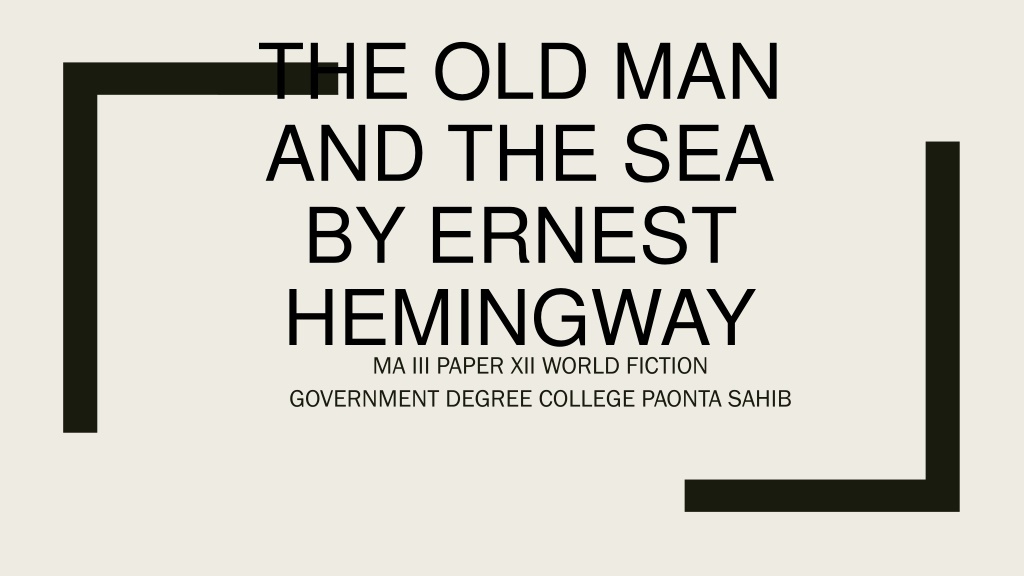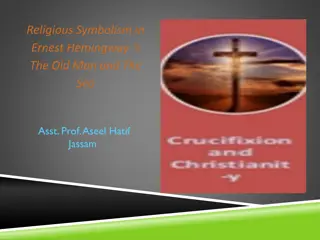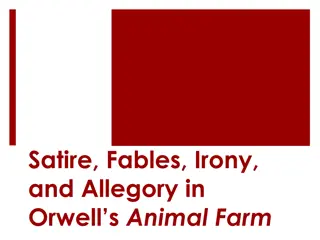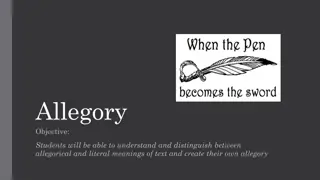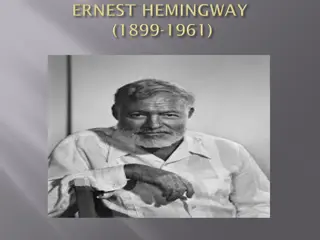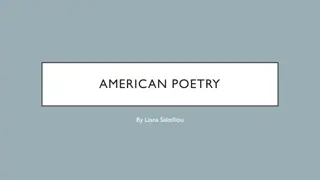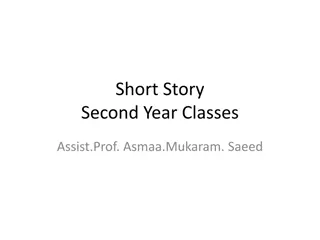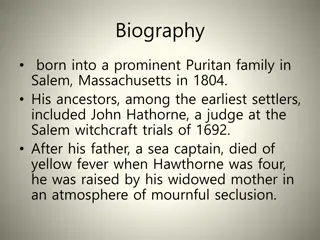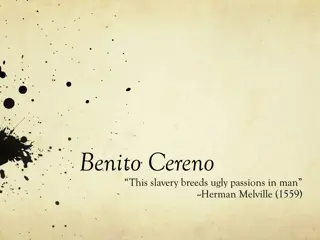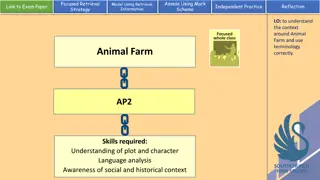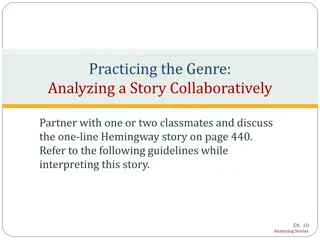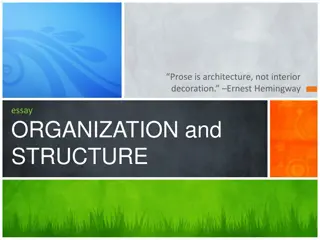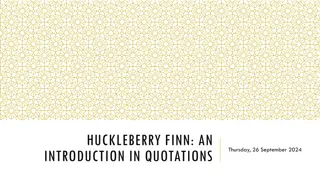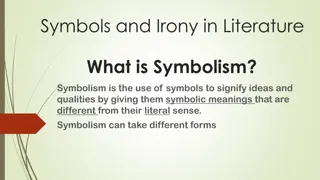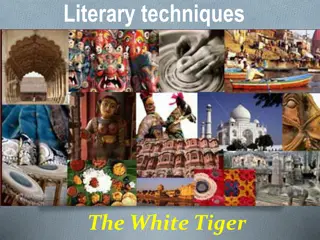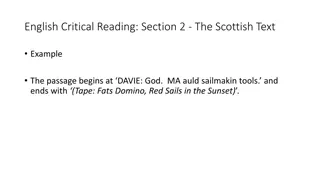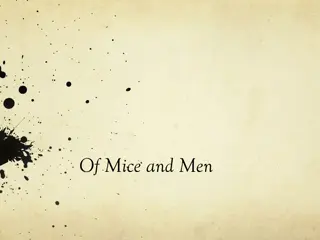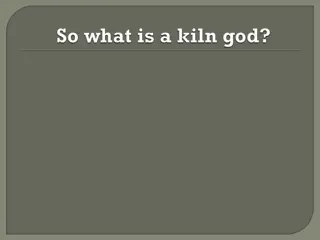Symbolism and Allegory in "The Old Man and the Sea" by Ernest Hemingway
In "The Old Man and the Sea," Hemingway uses profound symbolism and allegory to depict the struggles of Santiago, an old fisherman. The sea represents life's challenges, with Santiago's battle against the marlin and sharks symbolizing human endurance and heroism. The story explores themes of resilience, perseverance, and the pursuit of treasures amidst adversity, showcasing Hemingway's masterful storytelling.
Download Presentation

Please find below an Image/Link to download the presentation.
The content on the website is provided AS IS for your information and personal use only. It may not be sold, licensed, or shared on other websites without obtaining consent from the author. Download presentation by click this link. If you encounter any issues during the download, it is possible that the publisher has removed the file from their server.
E N D
Presentation Transcript
THE OLD MAN AND THE SEA BY ERNEST HEMINGWAY MA III PAPER XII WORLD FICTION GOVERNMENT DEGREE COLLEGE PAONTA SAHIB
Exposition ElementsSetting (time and place) A Cuban village near Havana Mostly set on the sea in the Gulf Stream Characters SantiagoOld Cuban fisherman ManolinThe boy who is Santiagos friend The giant marlin (symbolic) The sharks (symbolic) The sea (symbolic) Joe DiMaggio (symbolic
The Old Man in the Sea is an Allegory too!Santiagos struggle is an extended metaphor for the human condition---how we all struggle and take risks in a sea of unknowns. Through Santiagos struggle, Hemingway attempts to demonstrate what man can endure showing the nobility of the human endeavor in the face of extreme odds. Reminding us of Faulkners speech that man will not only endure, but he will prevail.
Symbolism---the seaThe major symbol is the sea, which stands for all of life on which humankind must sail. In both the sea and in life, there are a number of possibilities that lie hidden from the common eye some are gifts to be treasured and some are problems to be defeated. Theme It is the struggle that is all-important, and an individual obtains the status of hero if he/she battles the sea (life) with grace under pressure.
Symbolism on the SeaIn the novel, Santiago embarks on a sea journey (life) and encounters a giant marlin (treasure). He battles nobly to earn the treasure and then fights the sharks (problems) to save it. The struggle defines him as a hero. Even though he loses the treasure (the marlin) to the sharks (the problems), he has won the sea battle (life). He is destroyed, but not defeated.
The Marlin--many meaningsIn the beginning, the giant marlin becomes a symbol of the mysterious world of the unknown that challenges everyone. The marlin can also be seen as one of lifes treasures to be found and fought for---something to strive for (family, education, accomplishment) The fish is also a symbol of Christianity, and Hemingway imbues the giant fish with several Christian virtues kindness, patience, and determination. The fish is also described as being a source of food for others, a sacrifice so that others may live. The Marlin is also a symbol for Hemingways greatest works---his novels--- that he tirelessly suffers over
The Sharks-Evil in the worldThe sharks themselves are portrayed as malevolent creatures and symbolize the deadly forces of evil that reign in nature and life. The sharks seize the old mans prize from him and leave him shattered and shamed, just like sin can do in the world. The sharks also represent the critics who have been tearing Hemingways work (writing) to shreds.
Christ-like imagery--symbolic Christ figure---SantiagoSantiago endures 3 days on the sea The struggle with the marlin reflects Christs struggle on the cross Santiago bears the weight of the fish on his back (Christ carrying the cross) The wounds to his hands Biblical allusions abound
Christ-like imagery cont.When the sharks attack, Santiago utters a sound as a man might make involuntarily, feeling the nail go through his hand into the wood He is humble, long-suffering, courageous, he experiences failure, but is still not defeated
Religious Numeric SymbolismThe numeric symbolism in the novel also seems to be religious. Three, seven, and forty are numbers that have special significance in the Bible. As the story opens, the old man has unsuccessfully fished with the boy for forty days, followed by another forty-four days alone. His ordeal with the great fish lasts for three days, and there are three distinct stages in the struggle. Santiago finally manages to kill the fish on its seventh turn. Then he must battle seven sharks. His struggle with them is also divided into three sections.
Symbol of the Lions--strength, nobility of purpose, and inspiration.When the lions appear in their adult majesty, they suggest and signify great strength and nobility and provide Santiago with inspiration, a nobility of purpose, and a sense of vitality that goads him toward fulfilling his ambition.
ThemeAll of the symbols employed by Hemingway add to the basic theme that life is an endless struggle with illusory rewards. In order to gain nobility in life, a person must show bravery, confidence, courage, patience, optimism, and intelligence during the struggle. Then, even if the prize is lost, the person has won the battle, proving himself capable of retaining grace under pressure, the ultimate test of mankind.
Theme SummarizedIts not in the winning or losing (in life) that matters, it is how you play the game. Hemingways comment or opinion about life is that to be heroic, you must overcome lifes obstacles with dignity, decency, and courage so that even if you are destroyed, you are not defeated.
